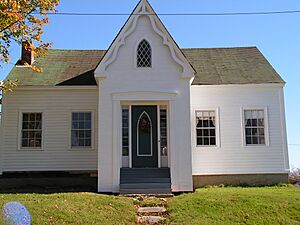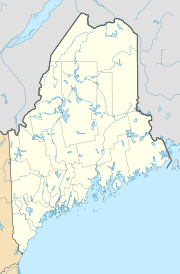Addison, Maine facts for kids
Quick facts for kids
Addison, Maine
|
|
|---|---|

|
|
| Country | United States |
| State | Maine |
| County | Washington |
| Area | |
| • Total | 100.47 sq mi (260.22 km2) |
| • Land | 42.44 sq mi (109.92 km2) |
| • Water | 58.03 sq mi (150.30 km2) |
| Elevation | 79 ft (24 m) |
| Population
(2020)
|
|
| • Total | 1,148 |
| • Density | 27/sq mi (10.4/km2) |
| Time zone | UTC-5 (Eastern (EST)) |
| • Summer (DST) | UTC-4 (EDT) |
| ZIP code |
04606
|
| Area code(s) | 207 |
| FIPS code | 23-00380 |
| GNIS feature ID | 0582316 |
Addison is a small town located in Washington County, Maine, United States. It was named after an English writer named Joseph Addison. In 2020, the town had a population of 1,148 people.
Contents
Geography of Addison
Addison covers a total area of about 100.47 square miles (260.22 square kilometers). Most of this area, about 58.03 square miles (150.30 square kilometers), is water. The land area is about 42.44 square miles (109.92 square kilometers).
Addison's Population Over Time
| Historical population | |||
|---|---|---|---|
| Census | Pop. | %± | |
| 1800 | 315 | — | |
| 1810 | 399 | 26.7% | |
| 1820 | 519 | 30.1% | |
| 1830 | 741 | 42.8% | |
| 1840 | 1,053 | 42.1% | |
| 1850 | 1,152 | 9.4% | |
| 1860 | 1,272 | 10.4% | |
| 1870 | 1,201 | −5.6% | |
| 1880 | 1,238 | 3.1% | |
| 1890 | 1,022 | −17.4% | |
| 1900 | 1,059 | 3.6% | |
| 1910 | 985 | −7.0% | |
| 1920 | 838 | −14.9% | |
| 1930 | 867 | 3.5% | |
| 1940 | 805 | −7.2% | |
| 1950 | 846 | 5.1% | |
| 1960 | 744 | −12.1% | |
| 1970 | 773 | 3.9% | |
| 1980 | 1,061 | 37.3% | |
| 1990 | 1,114 | 5.0% | |
| 2000 | 1,209 | 8.5% | |
| 2010 | 1,266 | 4.7% | |
| 2020 | 1,148 | −9.3% | |
| U.S. Decennial Census | |||
What the 2010 Census Showed
In 2010, there were 1,266 people living in Addison. Most of the people living in the town were White (96.4%). A small number of residents were African American, Native American, or Asian.
Fun Things to Do in Addison
Addison offers many outdoor activities. You can enjoy walking trails, explore different beaches, visit islands, and relax in local parks.
Historic Cemeteries in Addison
Addison has several old cemeteries. These include the Church Hill Cemetery and the Nash Cemetery at Addison Point. There are also cemeteries in areas like Wescogus and Indian River. These places hold the history of many families who lived in the town.
Famous People from Addison
- Henry Plummer (1832–1864) was born in Addison. He later became a sheriff in Montana. He was also known as a leader of a group called The Innocents.
See also
 In Spanish: Addison (Maine) para niños
In Spanish: Addison (Maine) para niños


